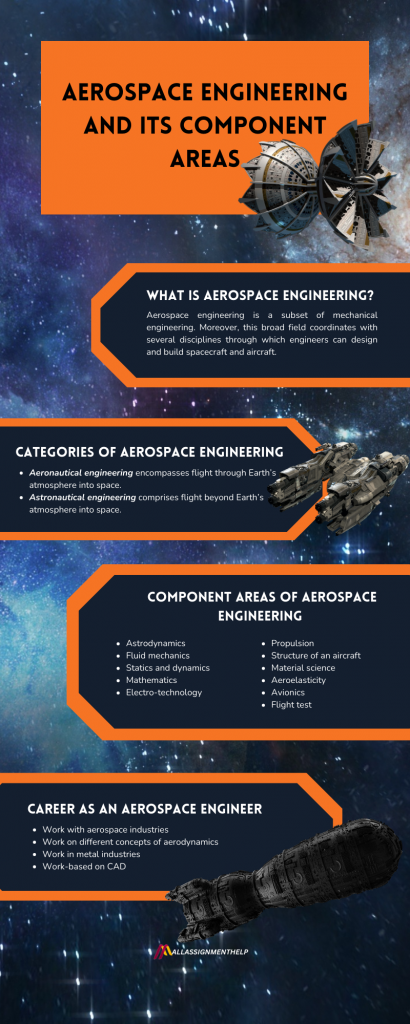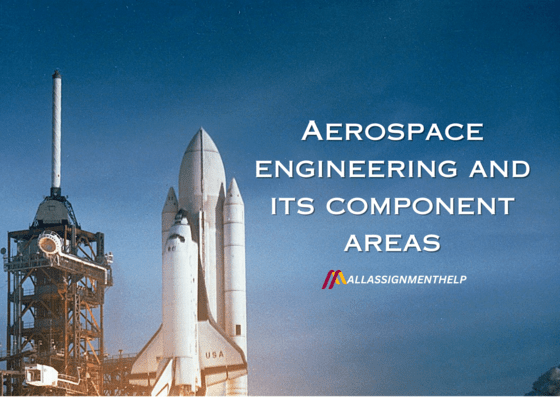Table of Contents
It is the result of continuous development in technology that today we are in space. Aerospace has made it possible for humans to travel in the surrounding space and explore the atmosphere. Moreover, aerospace engineering deals with design and manufacturing, research and development with which the field has developed to a great extent today. So, let us read more about aerospace engineering and its component areas through this blog of All Assignment Help.
What is Aerospace Engineering?
In layman’s terms, aerospace engineering is a subset of mechanical engineering. Moreover, this field is broad and it continuously coordinates with a number of disciplines through which engineers can design and build spacecraft and aircraft. Furthermore, students can use the teachings of this field in various disciplines. For example, if you have an astronautical engineering degree or aeronautical engineering degree, then you can easily apply your knowledge in airline crash investigations, windmill designs, flight simulations, and other fields with high technology needs.
In addition to this, experts have divided aerospace engineering into two major categories i.e. astronautical engineering and aeronautical engineering. In simple terms, we can understand both fields as:
- Aeronautical engineering encompasses flight through Earth’s atmosphere into space.
- Astronautical engineering comprises flight beyond Earth’s atmosphere into space.
Also, as an aerospace engineering student, if you ever come across academic challenges in subjects like physics, materials sciences, etc. then you must choose the right assignment help online services to guide you throughout. Furthermore, there are several areas that combine together to form aerospace. Let us take a look at them.
Physics
The subject matter generally deals with energy, force, matter, and motion. Moreover, it has different uses in aerospace and aeronautics. When aerospace calculates aircraft’s movement, astronautics deals with the effects of other bodies like the sun, moon, and planets.
Aerodynamics
It is a branch of physics that teaches students about the motion of air and its interaction with solid bodies like an aeroplane. This is needed to ensure the quick, efficient, and safe movement of aircraft or spacecraft when it comes in contact with air.
Thermodynamics
It is another branch of physics that deals with the link between heat and activity, covering things like combustion and fluid flow. In aerospace, it focuses on systems such as power generation and propulsion to calculate how heat impacts function.
Materials science
Another significant field in aerospace engineering is where you will get to study the properties of composites, polymers, ceramics, and metals. In addition to this, it will also prepare you with successful knowledge of which material will work perfectly for certain applications.
Acoustics
You must have heard of this term. It is a study where we learn how sound reacts with various objects. However, when it comes to aerospace engineering, if you get acoustics right, you can prevent components from breaking through vibrations. Furthermore, you can also make the interior of a craft bearable for the occupants.
Avionics
In electrical engineering, it is a branch, that has its focus majorly on the electrical systems in aerospace vehicles. Moreover, there are a number of things involved in it such as navigation, system design for control, communications, and performance.
Software
It is very similar to avionics with its significance in almost all areas of aerospace engineering. It is used for multiple reasons that include control of the craft’s control system and navigation, design of aircraft, and a lot more.
Furthermore, as we saw that aerospace engineering is multidisciplinary, we cannot expect an in-depth knowledge of all these areas from a single aerospace engineer. There is a huge man-force behind the design and development of spacecraft or aircraft. Additionally, as a student of aerospace engineering if you feel the need for more general industrial knowledge or composition you can ask an expert from a well-known assignment writing help service in the US for detailed assistance. You are the future of humankind; you must prepare yourself for every possible challenge.
Also read: Ways to Earn High Course Credits In Your Online Mechanical Engineering Class
Component Areas of Aerospace Engineering
Aerospace engineering is not a small subject. Moreover, it has various component areas. Let us look at them one by one.

Astrodynamics
It is the study of the motion of manmade bodies under the effect of gravity from one or more big natural bodies. This comprises spacecraft manoeuvre planning in orbit, approaches for determining where things are in space, and spacecraft attitude determination and control. Moreover, as an aerospace engineer, you must specialize in the optimization of astrodynamics problems, tackling issues such as mission design under restrictions, cooperative spacecraft manoeuvres, trajectory optimization, and orbit determination.
Fluid mechanics
It is the study of fluid behaviour (liquids, gases, blood, and plasmas) at rest and in motion. Moreover, it has numerous applications in mechanical and chemical engineering, biological systems, and astronomy. Also, it is the cornerstone of hydraulic design and equipment selection for gaseous fluid drilling.
Statics and dynamics
These are critical words in the design of any machine parts or equipment. Moreover, the science of dynamics is founded on the natural rules that control the motion of a particle. Furthermore, it is a discipline of science concerned with the study of forces and their effects on structures, machinery, and so on. Engineering mechanics, mechanics of solids, and mechanics of fluids are sub-disciplines of mechanics.
In addition to this, students come across a number of academic challenges during the course of their aerospace engineering degree. However, to overcome all such challenges they seek the required guidance from homework doers available online. As a student, you must let experts do certain things. This will only help you as you will come across some better ways to solve the complex issues related to statistics and dynamics during your study years.
Mathematics
As you know math has a vital role in all forms of engineering and so does aerospace engineering. Advanced level of math and physics is involved in aerospace engineering. Geometry, algebra, trigonometry, calculus, and vectors provide engineers with crucial mathematical skills for tracking processes and solving problems. Furthermore, differential equations, for example, are used in engineering issue-solving.
Also read: Civil Engineering Assignment Help in the UK
Electro-technology
It is a term used to explain the physics of electrical circuits, electromagnetism, and its applications in both electrical engineering and electronic engineering. In addition to this, electrical engineering, electronic engineering, instrumentation engineering, telecommunication engineering, and computer engineering are examples of specializations within electrotechnology.
Propulsion
The word is derived from two Latin words: pro, which means before or forward, and pellere, which means to drive. Moreover, pushing or driving a thing forward is referred to as propulsion. A propulsion system is a machine that generates thrust to propel an object forward. Furthermore, thrust is typically generated on aeroplanes by some application of Newton’s third law of action and reaction. Also, the engine accelerates a gas, or working fluid and the engine’s reaction to this acceleration creates a force.
Structure of an aircraft
It is the study of aircraft design. Moreover, it involves the physical configuration of an aircraft that experiences different forces during the flight. Aerospace engineers focus on making lightweight aircraft in order to provide a good flight experience.
Furthermore, during your aerospace engineering degree years, you will come across situations where you will feel pressurized with all the research compositions. Also, there are chances you will feel intimated with thoughts like who will do your assignment for structure etc. In such a case, you must discuss it with your peers, teachers, and students in advanced years.
Material science
This field is related to the structures. Aerospace engineers also learn about the materials used in the aircraft. This area involves the invention of new materials and modification and enhancements in the present ones.
Aeroelasticity
It is the study of the connection between inertial, elastic, and aerodynamic forces experienced by an elastic body when subjected to a fluid flow. Moreover, it has become an essential component of any aircraft engineering design as the search for lower weight and energy efficiency has intensified. Furthermore, newer studies have included wind energy, energy harvesting, and biological fluid-structure interactions.
Also read: Sneak Peek into the Zone of Mechanical Engineering
Avionics
It is a word that combines the words aviation and electronics. In aerospace engineering, avionics is an electronic system used in aircraft, satellites, and spacecraft to perform a variety of duties such as assisting in navigation, establishing communications, providing meteorological information, collecting flight data, and so on.
Flight test
This is a process of gathering information, known as data, that describes how a specific vehicle will perform. When there is insufficient evidence to establish that a vehicle will be safe and function as expected, flight testing is performed. Moreover, the data collected from flying tests is then used to build future vehicles. Furthermore, during flight testing, various motions known as manoeuvres are utilized to acquire this data.
Life of an Aerospace Engineer
Work with aerospace industries
Aerospace engineers work with companies manufacturing aircraft and spacecraft. Their work is to make satellites, aircraft, spacecraft, and ballistic missiles. Besides this, they also work on prototypes to make sure whether aircraft are working as per the requirements and safety standards or not. Engineers also make components like engines, landing gears, wings, control systems, and various instruments used in an aircraft. They also work on the destructive and non-destructive testing of aircraft, its functionality, how much it is, and the durability of aircraft in the long run.
Work on different concepts of aerodynamics
Aerospace engineers in today’s world are still working on basic aerodynamics and have knowledge of piston engines, and jets. Astronautical engineers work on different concepts such as the propulsion system of spacecraft, liquid fuel rockets, and ion drives. They also work on the life support system specifically as space missions involving humans require air, water, food, and waste product handling. These were the tasks an Astronautical engineer also does.
Work in metal industries
In space engineering knowledge of physics, mathematics and material science is a must. Professionals in this field work with metal alloys, polymers, ceramics, and composites. Understanding these things helps the engineer to know well the disastrous situations that may arise and how to tackle them efficiently.
Work-based on CAD
Nowadays aerospace engineers are also taking help from computer-aided design systems (CAD). Cad helps in the quick modification of designs of aircraft and 3D visualization of assembled parts. Computer simulation also helps in performing virtual testing of engines, control surfaces, wings, and aircraft under all atmospheric temperatures and conditions.
Conclusion
In this blog, we studied aerospace engineering and its components. We hope this blog was helpful for you and you were able to obtain the needed information. Alongside this, we can say that it has only become possible with the contribution of aerospace engineering that we have seen some incredible feats of mankind.
Frequently Asked Questions
| Question: 1 What is the content of aerospace engineering? Answer: 1 A greater section of content in aerospace engineering is very similar to the topics covered in mechanical engineering. For example, mathematics, aeronautics, computer applications, electricity, structure, physics, robotics, etc. |
| Question: 2 How many types of aerospace engineers are there? Answer: 2 There are multiple fields in which aerospace engineers can seek opportunity such as thermodynamics, flight mechanics, aerodynamics, acoustics, control systems, guidance, propulsion, etc. However, typically, aerospace engineers have two major classifications. These are, astronautics and aeronautics. |
